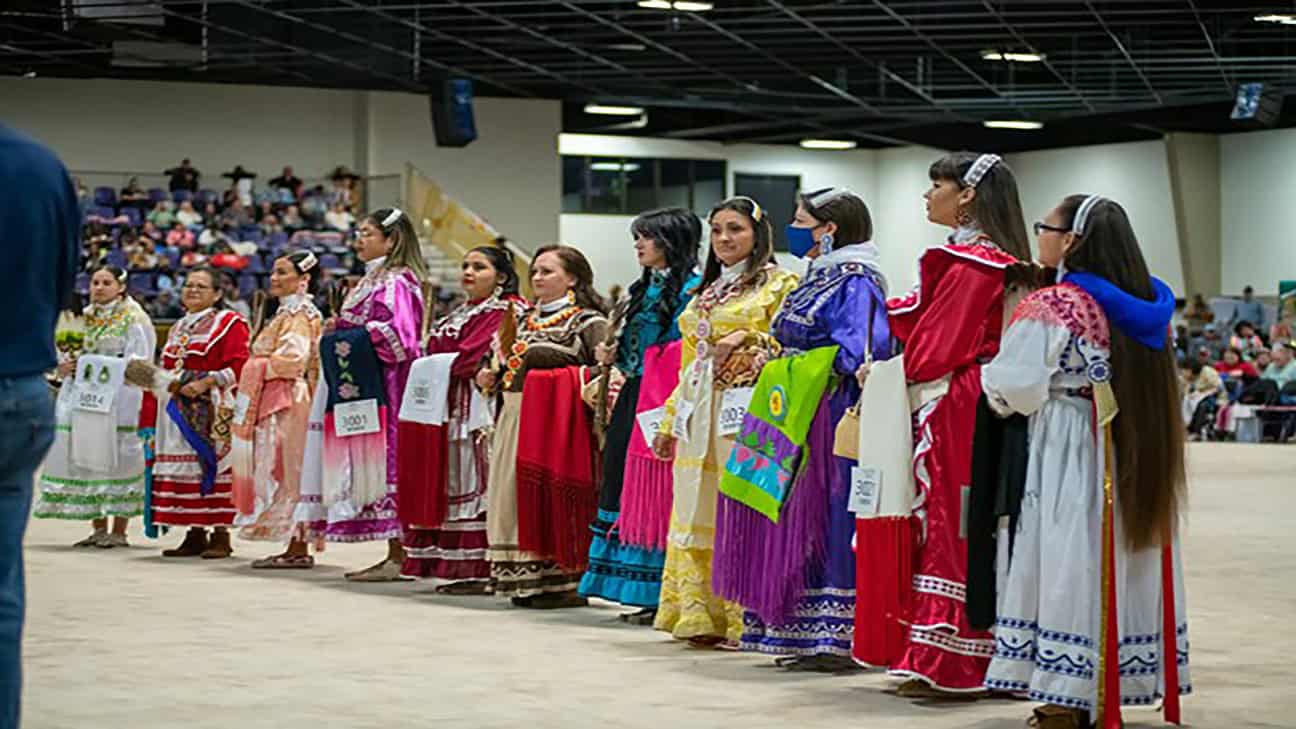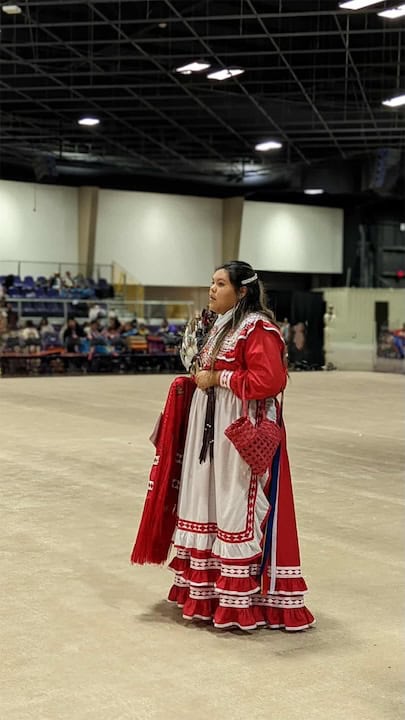
The Choctaw Powwow
Iti FabvssaPublished October 1, 2025Every fall, the sounds of bells and drums fill the air in Durant, Oklahoma, as thousands gather for one of the Choctaw Nation’s most celebrated cultural events—the Choctaw Powwow. Held at the Choctaw Event Center, this vibrant gathering is more than a showcase of dance and song; it is a living expression of Native American heritage and community.
Now in its 20th year, the Choctaw Powwow has grown into one of the largest and most prestigious powwows in the United States. In 1998, the Tvshkahomma Labor Day Powwow was first held on the Capitol Lawn (Willard Polk, personal communication, Sept. 15, 2025). As the popularity of the powwow at the Capitol grounds increased, the need for a larger event space grew. In 2005, the Choctaw Nation started hosting the powwow at the Choctaw Coliseum in Durant, Oklahoma; the event would later move to the newly created Choctaw Event Center in 2008. Today, with over 600 dancers, dozens of drum groups, and more than 13,000 attendees, the powwow draws participants from over 65 tribes across North America (Choctaw Nation of Oklahoma, 2023).
According to Powwows.com, the 2024 live stream reached 1.8 million views, with audiences tuning in from 119 countries. In 2021, the Tvshkahomma Labor Day Powwow was downsized so that the Choctaw Powwow Commitee could focus its efforts on the Choctaw Powwow in Durant. The Choctaw Nation Labor Festival still hosts the annual gourd dance at Capitol Lawn on Saturday.
The concept of the powwow originated among the Plains tribes, where gatherings were held to share songs, dances, and ceremonial traditions (Ponca Tribe of Indians of Oklahoma, 2023; Zotigh, 2010). These intertribal events fostered cultural exchange and unity. However, during the late 19th and early 20th centuries, federal policies such as the Religious Crimes Code of 1883 made it illegal for Native people to practice many of their traditional ceremonies.
Indian agents were authorized to use imprisonment, force, and the withholding of rations to suppress these cultural expressions, driving many practices underground (Native Americans in Philanthropy & Candid, 2025). Despite these prohibitions, Native communities preserved and adapted their traditions, and powwows reemerged as powerful symbols of resilience, identity, and cultural survival.
During World War I, Native Americans from historically rival tribes served together in the U.S. military, forging bonds through shared sacrifice. Upon returning home, many set aside tribal divisions and came together in ceremony—dancing to a common drumbeat. The American flag, once seen by many as a symbol of oppression, began to represent unity and resilience. Tribes revived warrior traditions to honor these veterans as modern-day warriors (Zotigh, 2010), and new powwow protocols emerged, blending traditional customs with contemporary practices.
By the 1950s, powwows had spread to urban areas as Native people relocated for work, creating new opportunities for cultural exchange (Zotigh, 2010). Powwows became a way to connect across tribal lines and foster a shared identity. Today, they take place across the United States and Canada and have even reached Europe. Much like professional sports circuits and like rodeo, the powwow circuit is a year-round lifestyle for many. As Native communities navigate both modern life and traditional values, powwows continue to evolve.
During the 20th century, Choctaw people began participating in powwows, leading to family traditions that exist within our communities today. Within the Choctaw Nation, the community has hosted a variety of powwows and cultural gatherings, from smaller community events to large-scale celebrations. Towns like Canadian, Poteau, Durant, and Broken Bow have hosted local powwows and cultural days, often supported by the Tribe, local communities and schools, and programs like Johnson-O’Malley (JOM).
In 1987, Pittsburg County hosted its 2nd Annual Choctaw Arrowhead Powwow at Arrowhead Resort near Canadian, Oklahoma, on Lake Eufaula. The two-day event featured gourd dancing, contest dances, and a community meal, offering a rich celebration of Choctaw tradition and intertribal participation (Okmulgee Daily Times, Aug. 28, 1987:10)
Poteau’s powwow, also supported by JOM and Poteau Public Schools’ Indian Education Program, ran for at least a decade into the late 1990s, serving as a vibrant celebration of Native identity and youth involvement (Dewayne Hornbuckle, personal communication, Sept. 15, 2025).

In 1993, the Choctaw intertribal Powwow was started in Durant, Oklahoma.
Hosted at various locations like the Bryan County Fairgrounds and at Southeastern Oklahoma State University, the powwow featured arts and crafts vendors, food concessions, and traditional dance exhibitions like gourd dancing.
This event sparked the idea for what would become the annual Choctaw Powwow in Durant (Monica Blaine, personal communication, Sept. 15, 2025; The Daily Oklahoman, April 19, 2002:18).
One notable example is the American Indian Youth Leaders Council Spring Powwow, held annually at the Broken Bow Sports Complex. Beginning in 1996. Now in its third decade, this event is organized by the American Indian Leaders Youth Council of Broken Bow Public Schools, a student-led club that takes charge of planning and hosting the powwow (Brenner Billy, personal communication, Sept 15, 2025).
Powwows are not only a celebration of life but a vital form of education. They serve as gathering spaces to celebrate and maintain tradition while inviting visitors to experience Indigeneity firsthand.
Tribes, families, and individuals come together to feast, hear their languages spoken, exchange Indigenous-made arts and crafts, sing, dance, and uphold tribal customs.
At the heart of every powwow is the drum and its singers who provide the musical accompaniment and set the tempo for the dances. Powwow dancing is the most visible part of the powwow. The first dance typically hosted at a powwow is the gourd dance, which originated with the Kiowa people when a Red Wolf gifted his songs and dances to honor warriors and veterans. Over time, gourd dance became a respected prelude to powwows. At most powwows, Grand Entry follows the gourd dance.
A parade of dancers lined up by dance style and often age, from oldest to youngest enters the arena.
Modern innovations in powwow dance include the men’s fancy, men’s chicken and women’s fancy shawl, which began less than a century ago. Other categories include the northern men’s traditional, men’s southern straight, men’s grass, women’s northern and southern traditional, and women’s jingle. Unique to the Choctaw powwow are the Choctaw women’s traditional and men’s woodland, which highlight southeastern tribal customs.
Just across the road from the powwow, the Choctaw Cultural Center deepens the experience with immersive exhibits, traditional cuisine, and engaging programs.
Throughout powwow weekend, they will be hosting the Choctaw Heritage Festival. Guests are invited to take part in Choctaw language singing, join in social dances, and savor Indigenous dishes like frybread and hominy at the on-site Champuli Café (Choctaw Cultural Center, 2025).
The center’s living village and interactive classrooms provide a rich window into Choctaw lifeways, turning Durant into a vibrant, multi-sensory cultural journey. Also at the Choctaw Cultural Center on Saturday, Nov. 1, will be the annual stickball tournament and exhibitions, hosted by the Choctaw Nation Cultural Outreach Department.
The Choctaw Powwow is more than a gathering; it is a powerful expression of pride and can be meaningful to everyone involved, whether dancing, singing or simply spectating.
From toddlers not yet walking, to grandparents sharing their stories, it is a space where all can come together and connect. Open and free to the public, the event welcomes both tribal citizens and non-Native visitors to listen, learn, and join in honoring a living culture.
Works Cited
- Choctaw Cultural Center. (2025, Sept. 15). Choctaw Heritage Festival – Choctaw Cultural Center. Choctaw Cultural Center.
- Choctaw Nation of Oklahoma. (2023, Oct. 23). Choctaw Powwow to Open Native American Heritage Month – Choctaw Nation of Oklahoma. Choctaw Nation of Oklahoma.
- Native Americans in Philanthropy, & Candid. (2025). The Religious Crimes Code of 1883 bans Native dances and ceremonies.
- Investing in Native Communities. Ponca Tribe of Indians of Oklahoma. (2023). Our annual celebration. Ponca Tribe of Indians of Oklahoma. Powwows | the encyclopedia of Oklahoma history and culture.